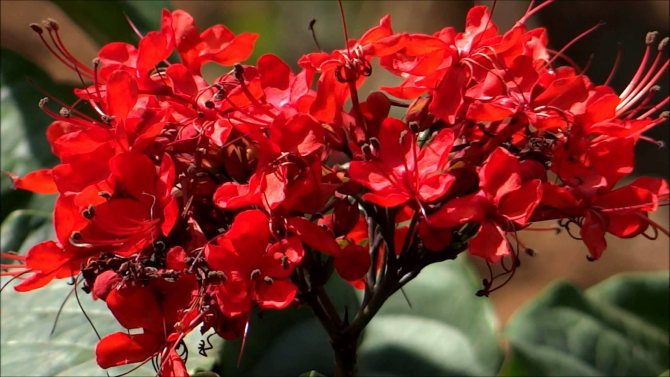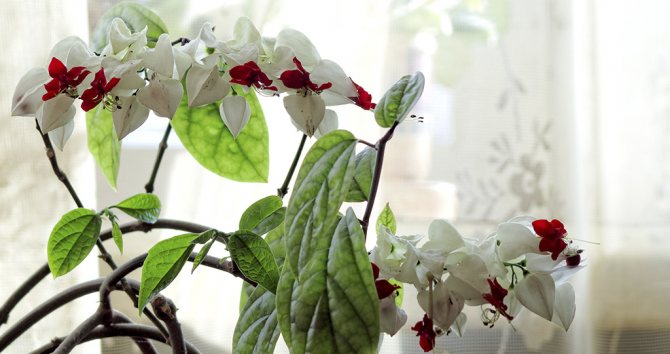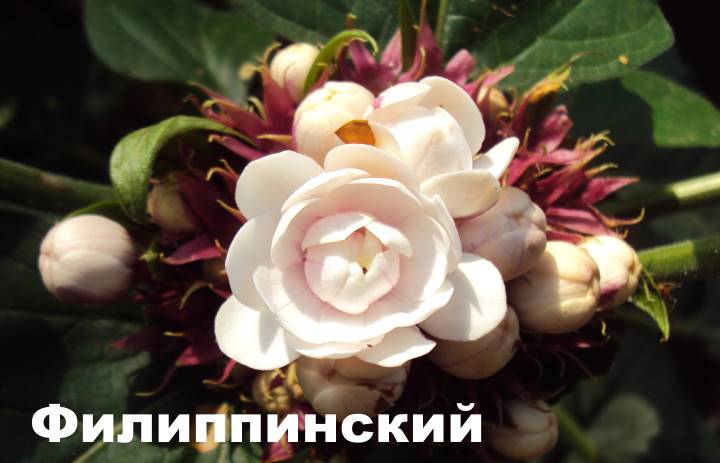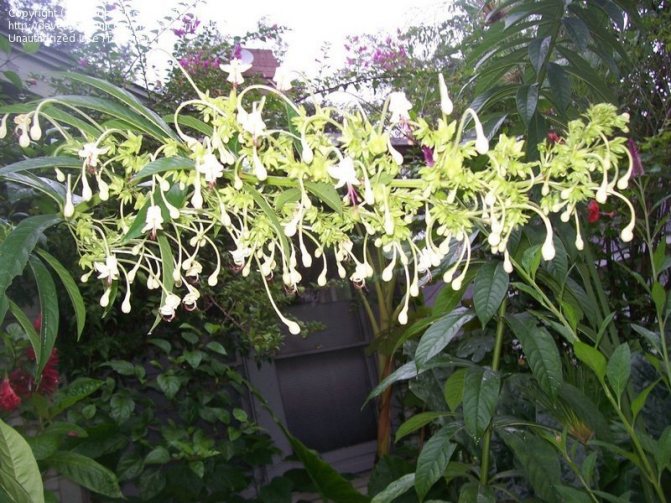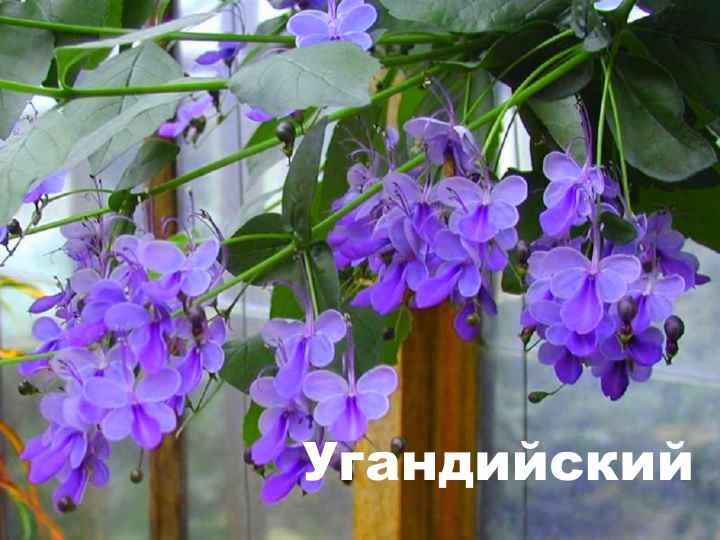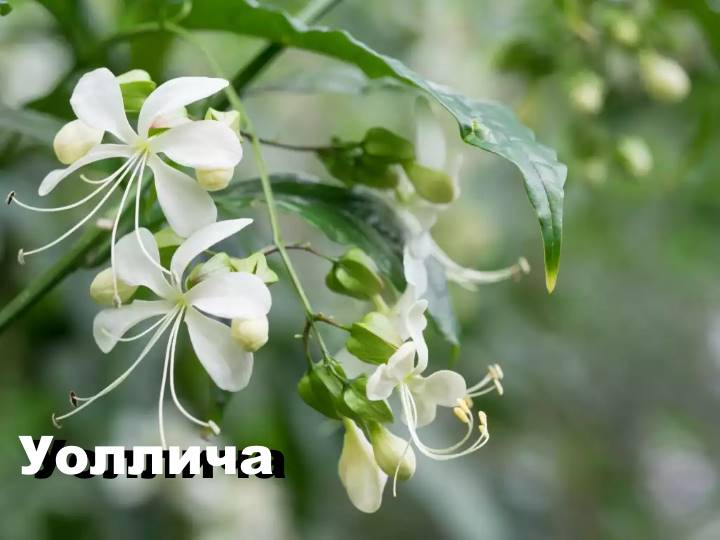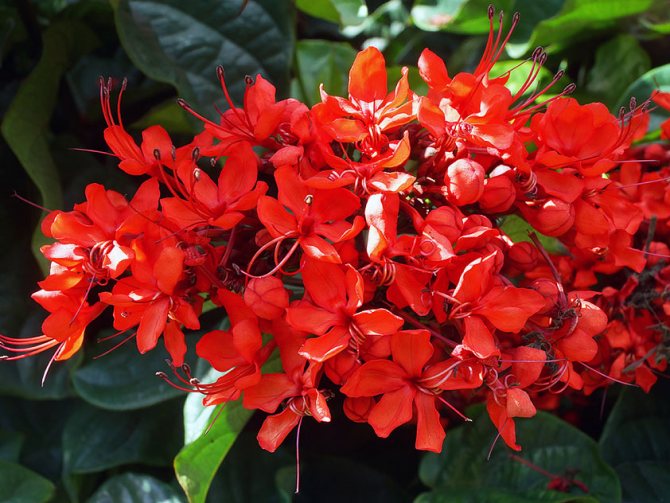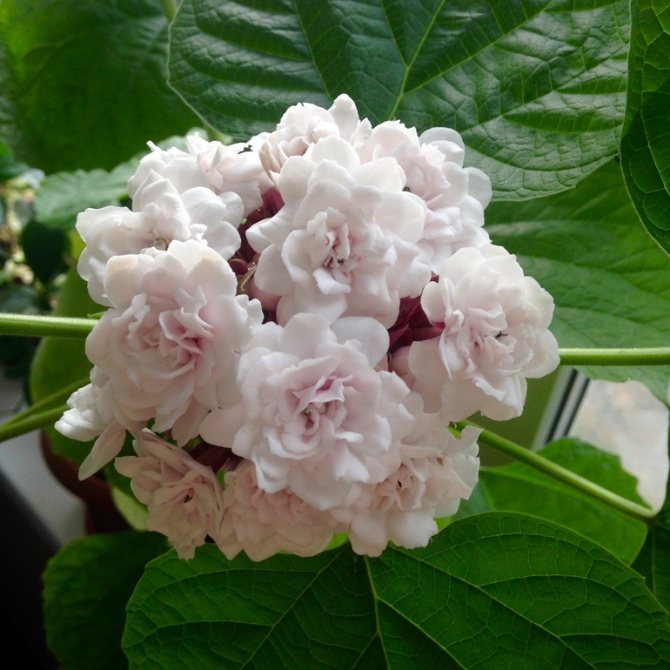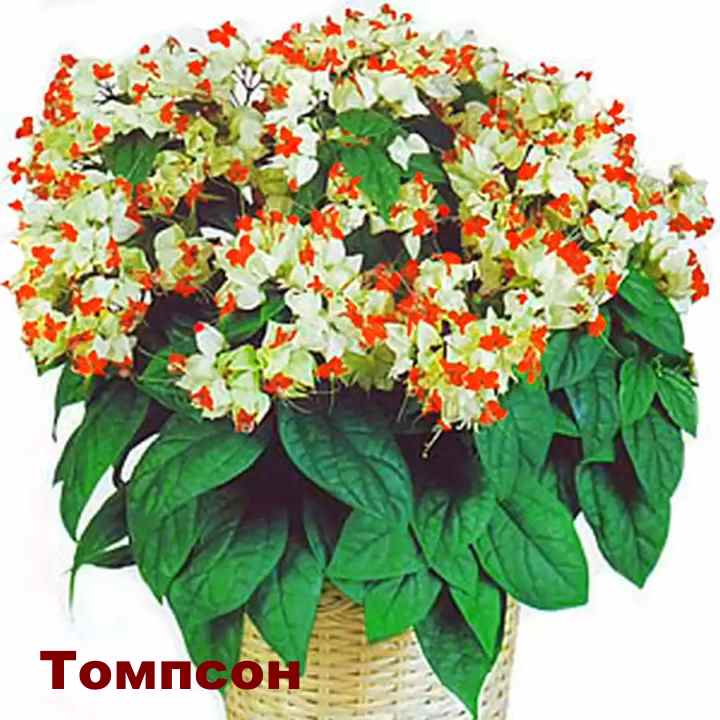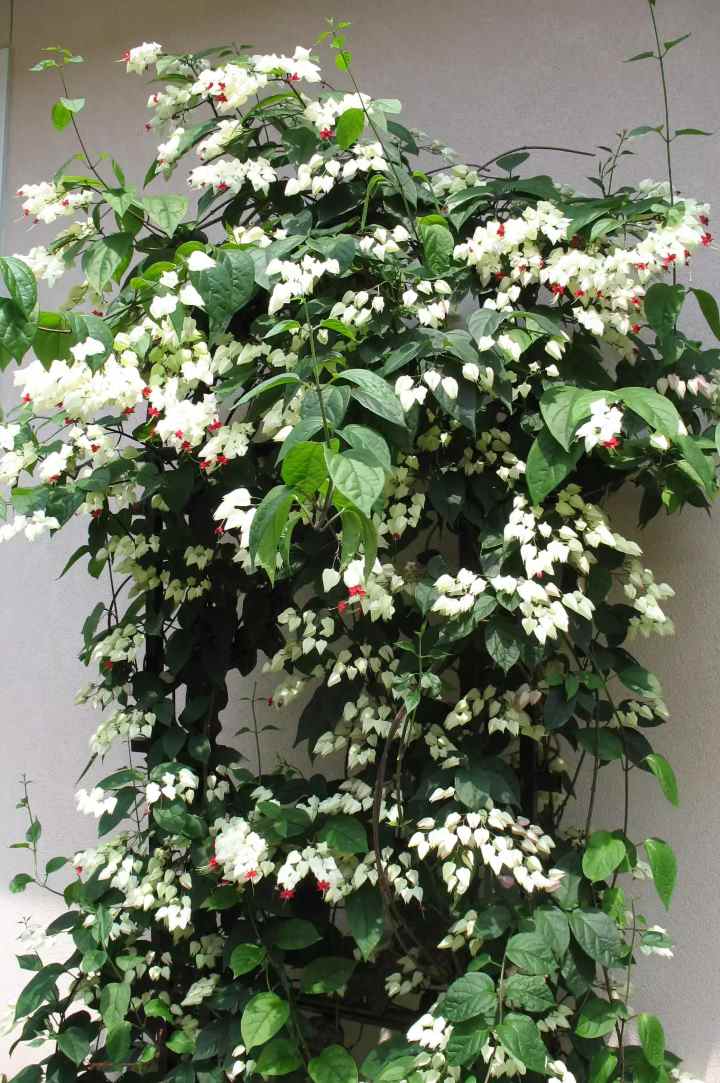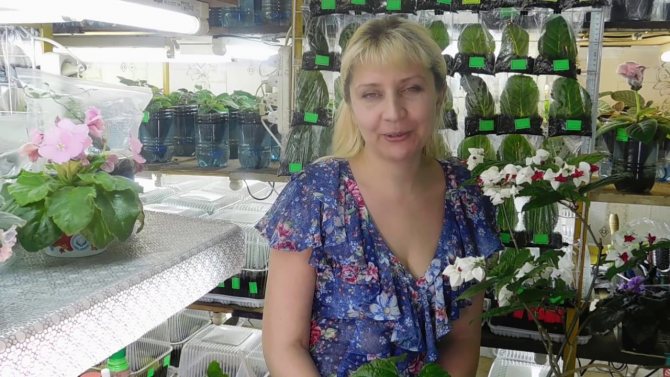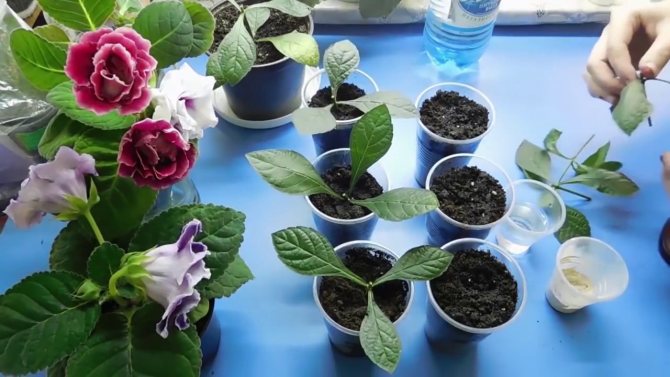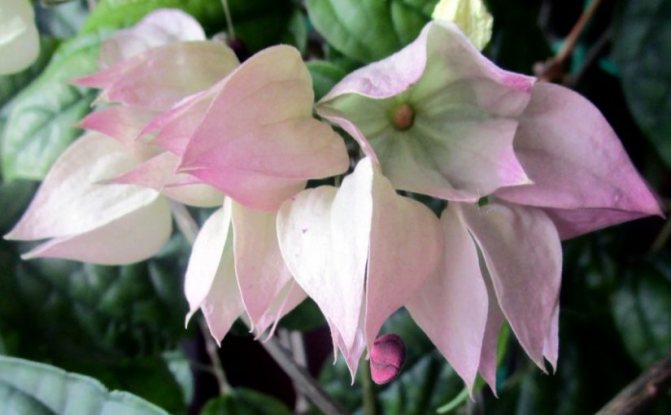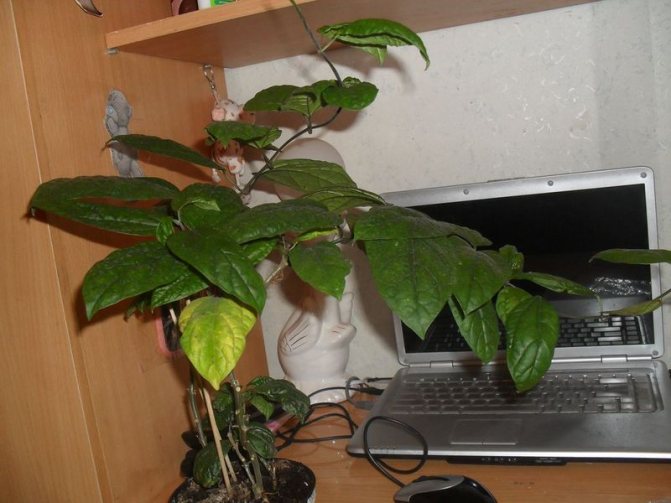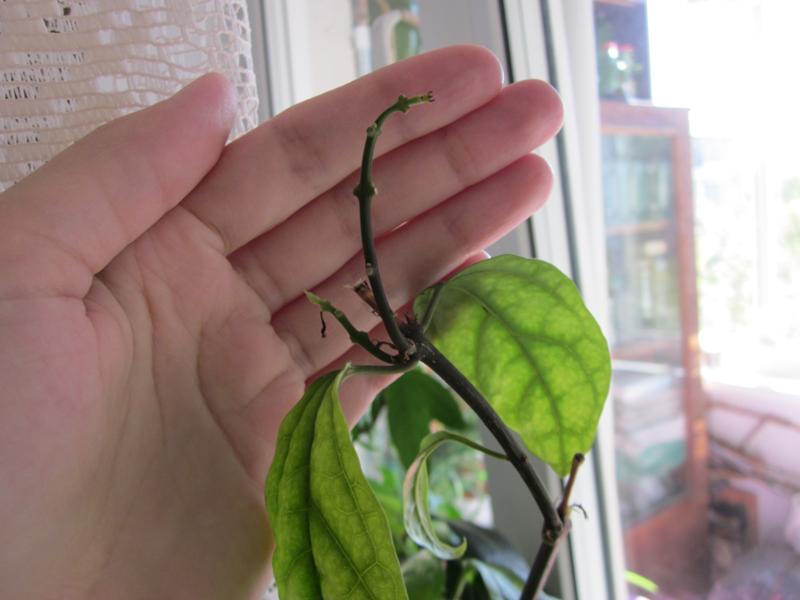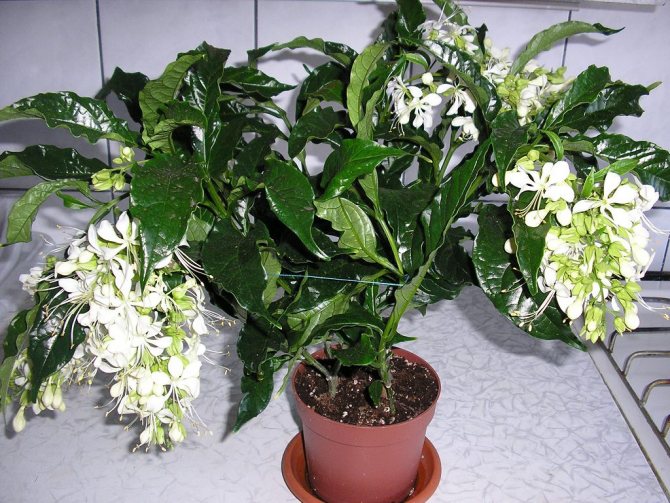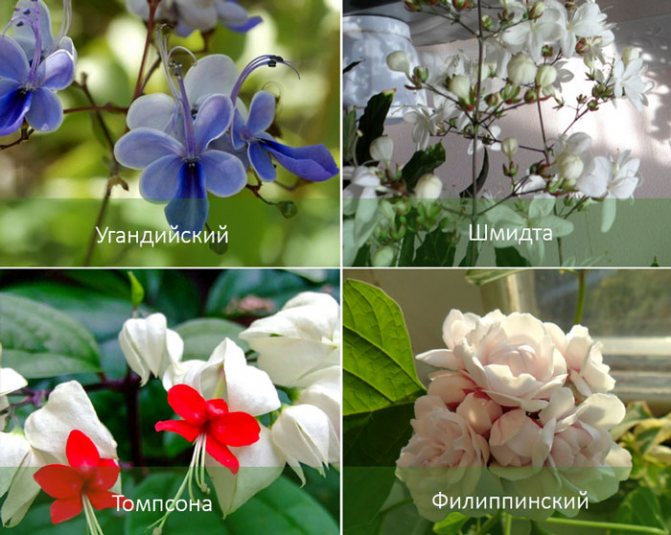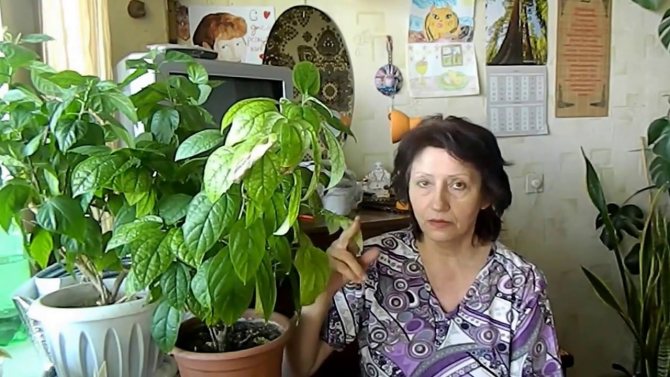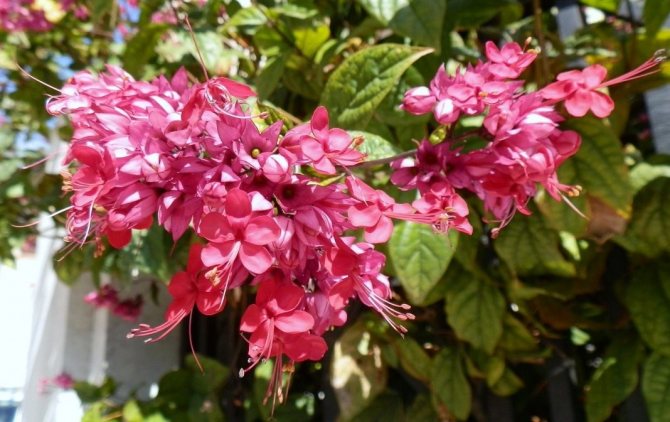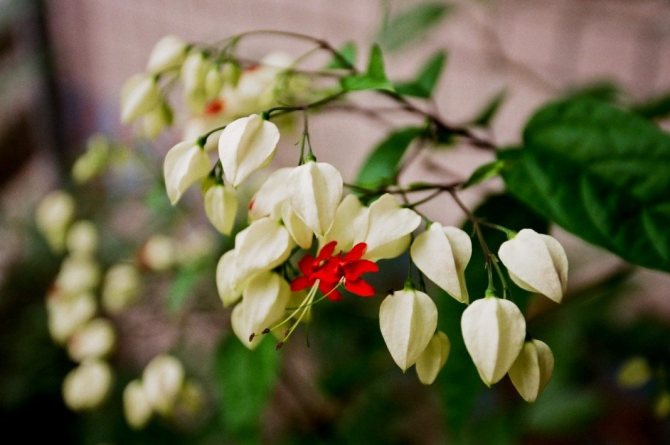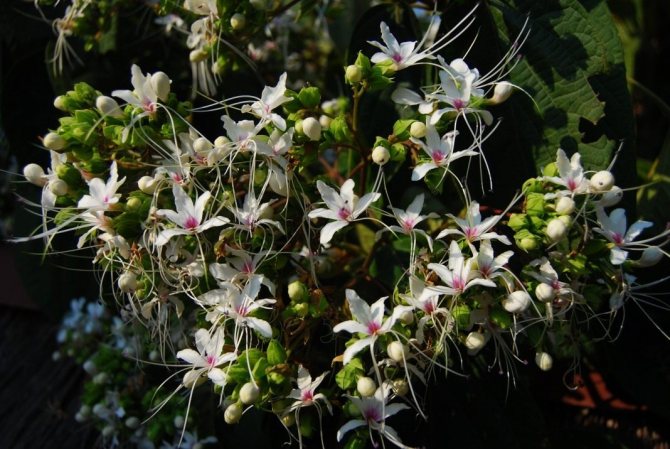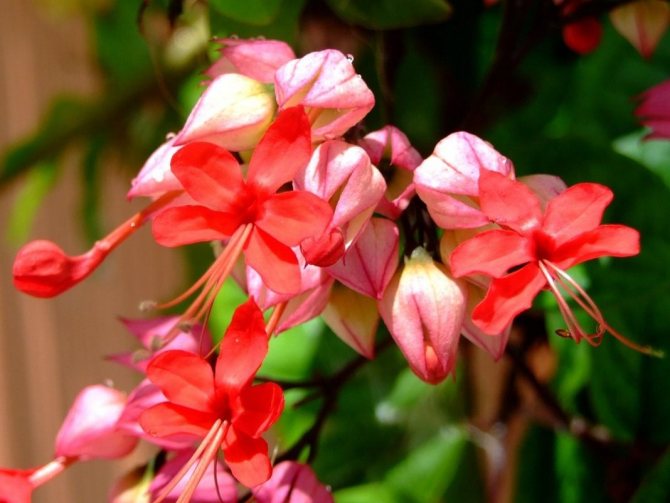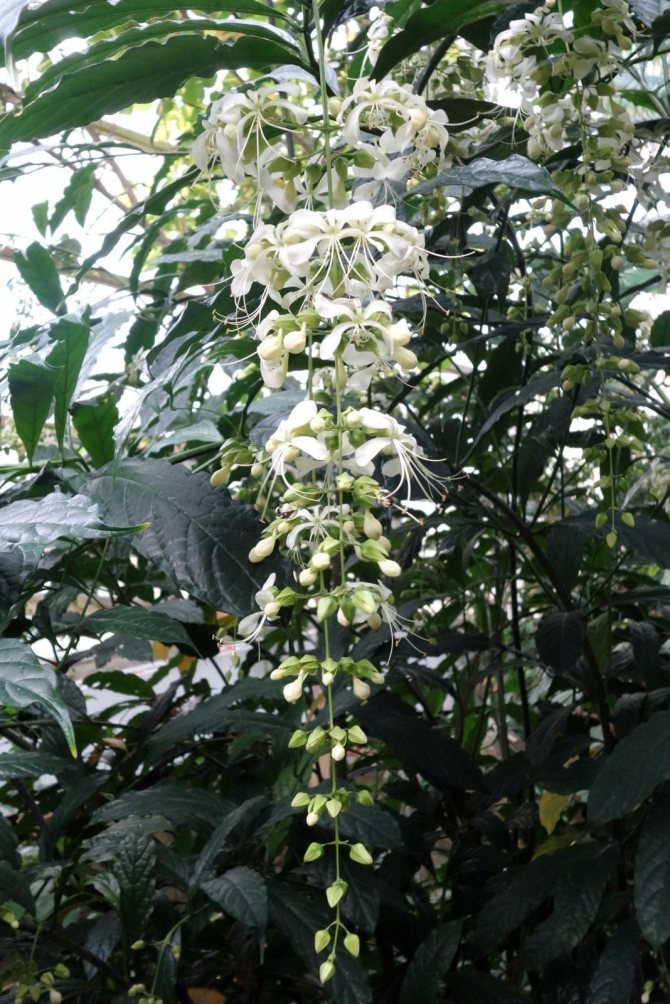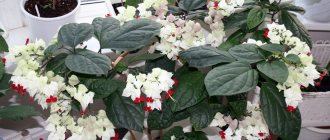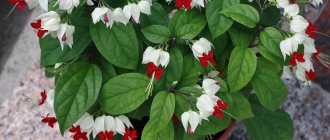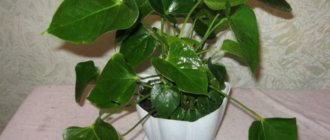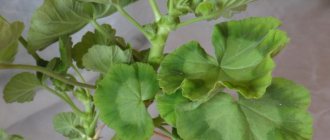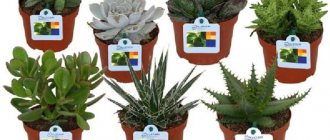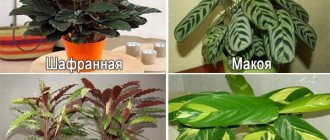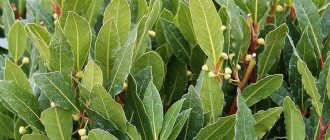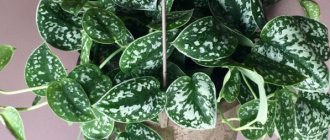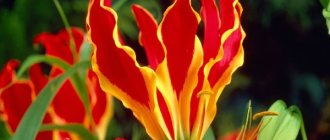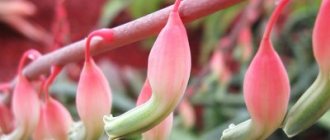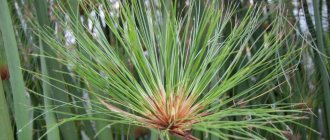Botanical description
Clerodendrum is an evergreen climbing plant native to the tropics of Africa and Asia. The plant got its name thanks to a Japanese legend and literally translated the name sounds like "the tree of fate." The popular name for clerodendrum is innocent love or volcameria.
The leaf mass of the bush has jagged edges, and the shape of the leaf resembles a heart. Flexible stems with rapid growth quickly lignify. The aroma of blossoming flowers is unique and pleasant. Flowers with their petal shape resemble exotic butterflies. The plant has a scent not only flowers, but also leaves.
Relative of verbena
Clerodendrum is a perennial plant of the vervain family.
Translated from Greek, clerodendrum is a tree of fate (cleros is fate, dendrum is a tree).
The genus contains about four hundred species of herbaceous and woody plants, as well as lianas and shrubs. Clerodendrum is found in the subtropics and tropics of South America, Asia and Africa.
Thompson's Clerodendrum is one of the most popular varieties
The leaves of the clerodendrum are large and shiny, the flowers, depending on the variety, are white, pink or blue, graceful in shape, reminiscent of a butterfly.
Types and varieties with photos
There are more than 300 different species in the genus, but growers breed several adapted for growing at home.
Clerodendrum Filipino
The aroma of C. philippinum is reminiscent of jasmine. At night, the smell spreads strongly, filling everything around. Inflorescences fill 3 cm - these are white-pink roses. The diameter of the inflorescences reaches 20 cm. The dark green foliage favorably emphasizes the blossoming flowers. Propagation of this species is quite easy, as it forms many layers around the trunk.
Clerodendrum Filipino pictured:
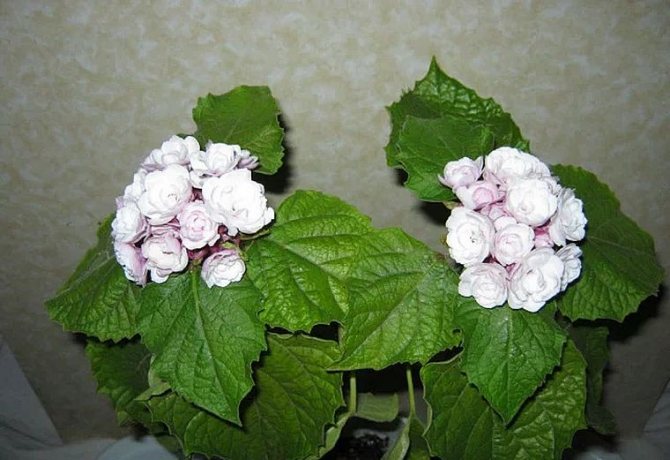
Wallich (Prospero)
Wallich's Clerodendrum (C. Wallichiana) is today known as Prospero. The branches have a beautiful reddish-green hue. The leaf plates are dark green, oval in shape. Blooming white flowers have a delicate aroma. This type requires a lot of diffused light, otherwise its compactness is violated, the branches are stretched, spoiling the appearance.
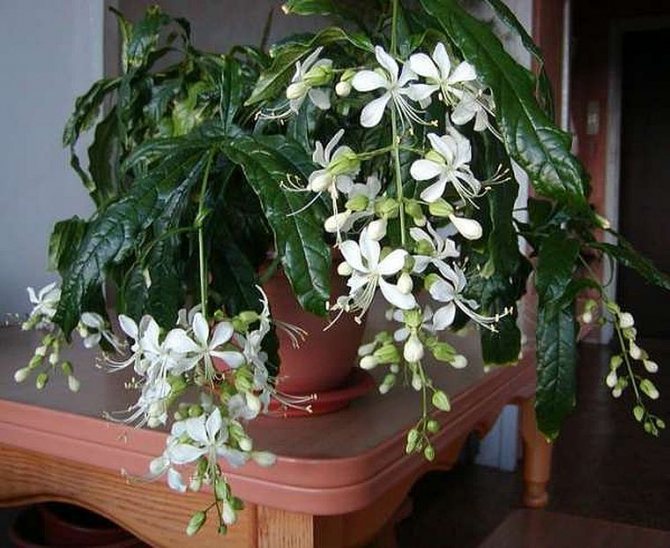

Schmidt
Clerodendrum Schmidt (C. Schmidtii) looks more like a small tree than a shrub. Leaves are oval, with wavy edges. During flowering, beautiful white flowers bloom.
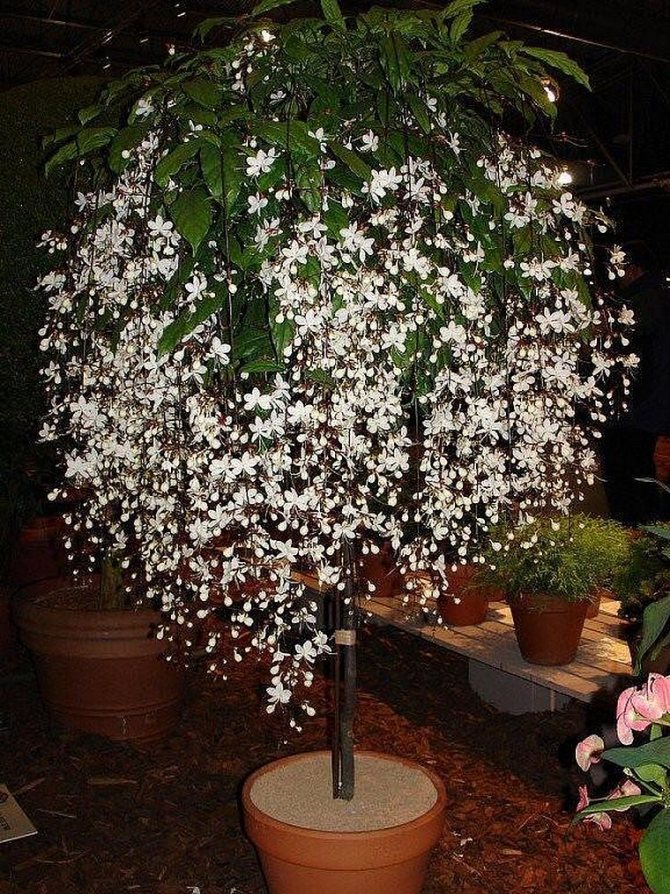

Inerme
Clerodendrum (C. Inerme) has oval green foliage with a prominent central vein. The white flowers resemble butterflies with purple splashes.
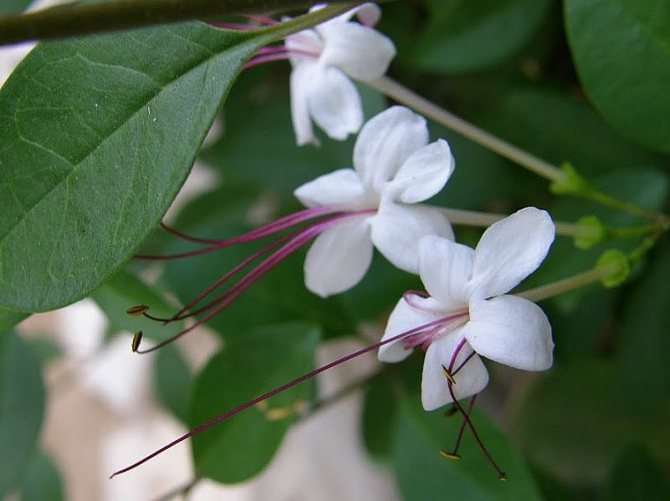

Inerme variegata (C. inerme variegata) differs from the ordinary species of inerme only in leaf color. Lighter spots follow it in a chaotic mosaic, which looks quite attractive.
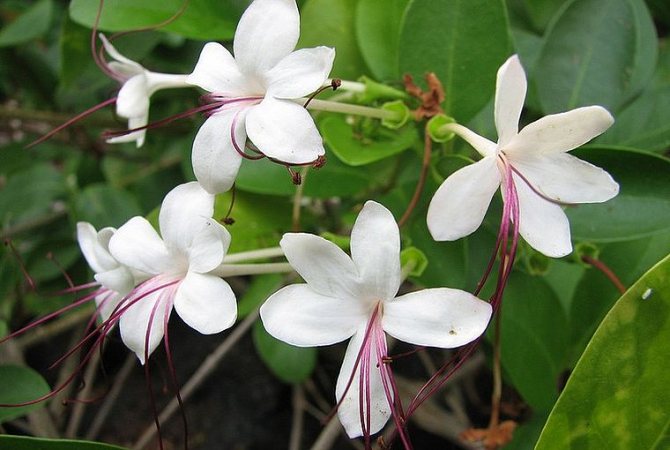

Bunge
Clerodendrum benge (C. bungei) is growing rapidly. Flowers with an attractive appearance - small pink buds are collected in large inflorescences. It has a long flowering that lasts all summer.
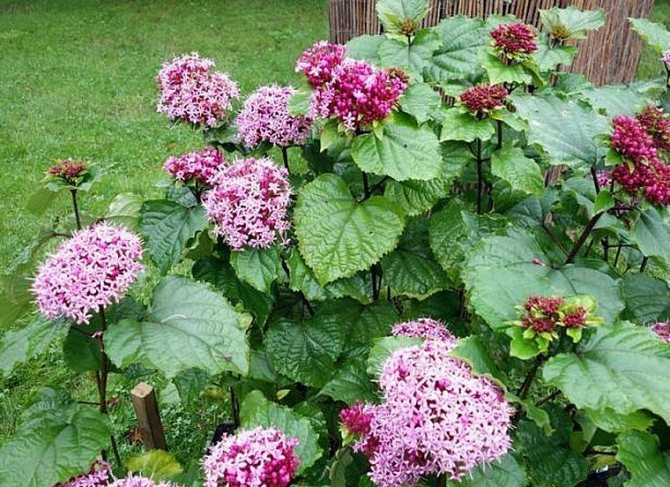

Specialozum
Clerodendrum speciosum (C. speciosum) grows sprawling, and its height is 3 m in adulthood.The leaf plates are large, rounded, located on the petioles of a reddish hue. The flowers have a purple hue.
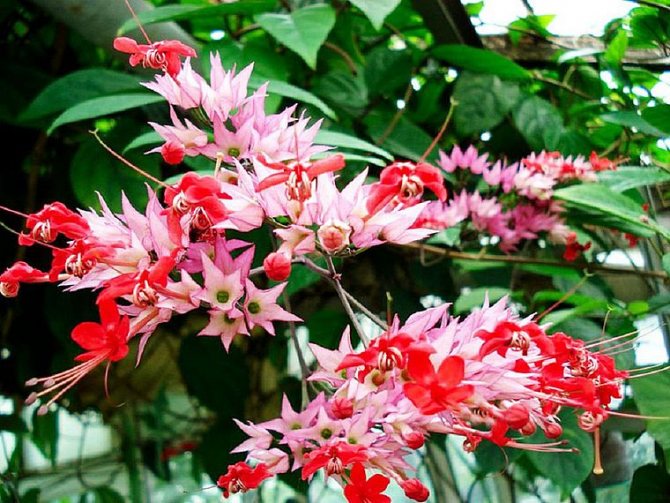

Aculeatum
Clerodendrum aculeatum (C. aculeatum) has white, fragrant flowers. At the same time, they are not collected in inflorescences, but are located singly in 3-5 pieces. The bush grows compact.
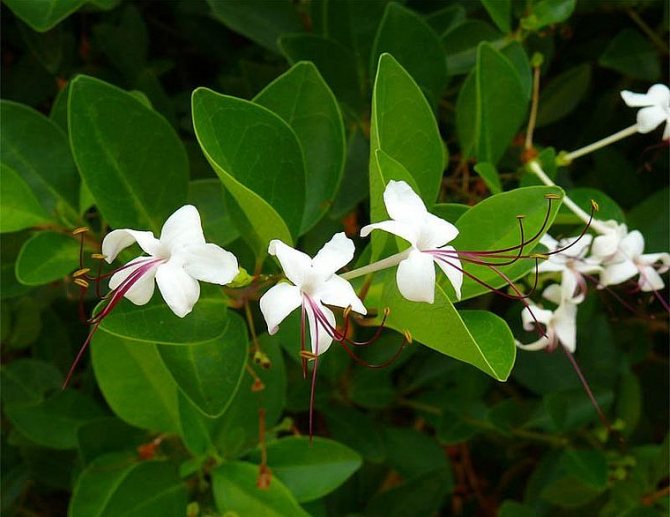

Champagne Splash (C. Indicum)
This rare plant looks like a shrub with elongated leaves. The flowers are arranged on long legs like champagne splashes flying around.
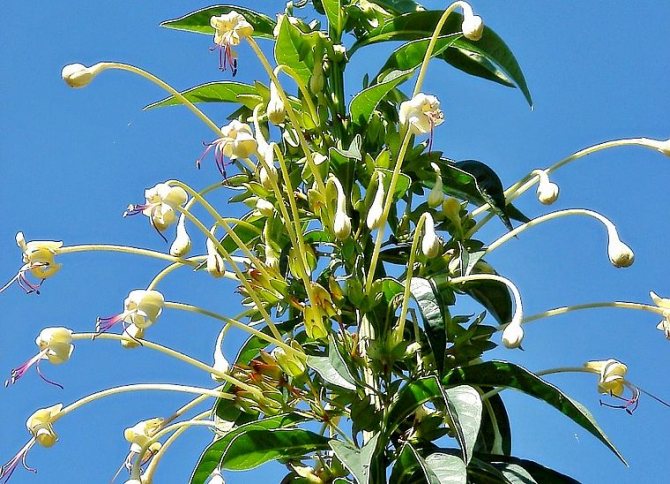

Also, among amateur flower growers, you can find such beautiful species, but they are quite rare - Thomson's clerodendrum (C. thomsonae) and Ugandan (C. ugandense).
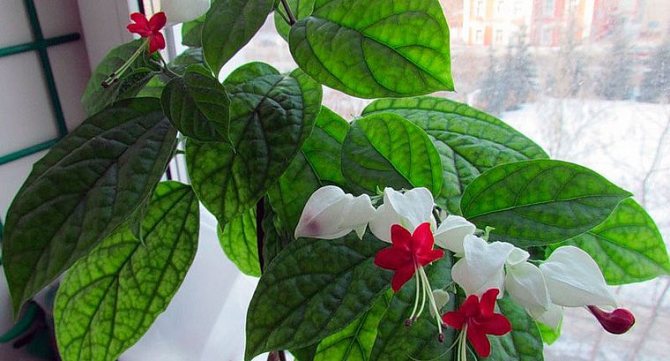

Thomson
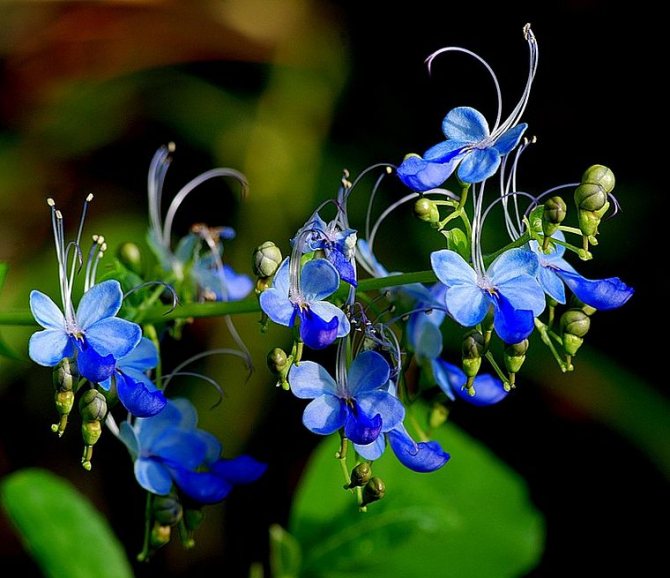

Ugandan
Home care
In order for the indoor flower clerodendrum to develop well, it is necessary to organize proper care for it at home. Continuous cultivation errors can lead to the loss of the flower as a whole.
Where to put the flower, soil
Direct sunlight damages the clerodendrum as it burns its delicate foliage. But at the same time, he needs a lot of diffused light. In a room with a south-facing window, the flower is placed in the back of the room for the summer time, and for the winter it can be placed on the windowsill closer to the light source. He will have enough lighting on the northern windows in the summer, but in the winter he will need to be illuminated with special lamps for plants.
The soil can be purchased at the garden center for decorative deciduous plants, and before use add coarse sand and vermiculite to it.
If the flower experiences a constant lack of sunlight, then flowering will not occur.
Lighting, temperature, humidity
There should be a lot of lighting, but the sun's rays can hit the plant only in winter. The temperature regime of the plant is average:
- In summer - 18-25 ° C. At higher temperatures, the leaves can deform and fly away from the hot air.
- In winter, it is best to organize a dormant period, during which the air temperature should be in the range of 15-18 ° C.
The humidity in the room should be increased, therefore, spraying with warm water from a fine spray is carried out twice a day. And in hot weather, the flower is put on a pallet with expanded clay and water to increase the humidity of the air.
Do not put the clerodendrum over the radiator, as this will harm the plant.
Watering
During vegetative growth, the plant needs a lot of water, so we water it once a week with a large volume of water. To completely saturate the clod of earth, it is best to use immersion irrigation technology. For this, a container is selected so that a pot with a plant is almost completely immersed in it, and settled soft water is poured into it. As soon as the top layer of the soil becomes wet, the flower is removed from the water, the excess liquid is allowed to drain and put on a pallet.
In winter, watering is reduced, and the cooler it is in the room, the less water is needed for irrigation. This will also stimulate the dormant period so necessary for bud setting.
Fertilizers, top dressing
Top dressing is applied only after watering on wet ground, so as not to burn the root system. They are used only in the warm season in April-August. Purchase fertilizer labeled "For flowering plants" - this will help to achieve lush flowering of the bush.
Fertilizers are applied according to the instructions indicated on the package, and it is impossible to increase the frequency and dosage of feeding on your own.
Dormant period
The flower has a dormant period in the winter, without which it is impossible to get the summer flowering of the bush. To organize rest, you must:
- By the end of September, significantly reduce watering to ripen the branches.
- From the beginning of September, do not apply fertilizer under the bush.
- Choose a place in the room so that the air temperature does not rise above the 18 ° C mark.
The main feature of winter home care for clerodendrum is a noticeable reduction in watering. In the summer, the earthen coma must not be allowed to completely dry out.
Trimming, shaping
Clerodendrum pruning is carried out annually in early spring. This will help shape the bush as well as eliminate deformed winter growth. Moreover, the branches are cut by 1/3 - this will also stimulate the lush flowering of the bush.
By trimming the clerodendrum, a stem can be formed. This is not difficult to do - with intensive growth of the stem, all lateral shoots are completely removed. At a height of 75 cm, pinch the top. And then the bush at the top begins to grow to the sides. In the second year, shaping pruning is done, giving the bush the shape of a ball, since with active growth, some branches are ahead of others, and the shape of the trunk is not very beautiful.
Transfer
Young plants are transplanted annually, transplanting them into a slightly larger container. It is not worthwhile to greatly increase the pot, as the plant may stop growing. The soil is purchased with the mark "For decorative deciduous plants."
Transplant technology:
- The selected pot must have holes for draining the water.
- Put expanded clay on the bottom of the pot with a layer of 2-3 cm.
- We fill in the substrate.
- In the middle we make a depression in which we put the root system of the seedling.
- We fill up the soil to the level of the root collar, slightly squeeze the seedling with our hands, compacting the soil around the trunk. This helps to get rid of air spaces in the soil and the seedling adapts more easily to a new place.
We carry out the first watering a day later. This time is necessary so that the wounds received by the plant during transplantation are healed, and the ingress of moisture does not cause rotting of the roots.
Reproduction of clerodendrum by seeds
Seed propagation is carried out in the spring. To do this, fill the container with a mixture of peat and sand, slightly moisten and sow the planting material, slightly pressing it into the soil. After that, it is covered with plastic wrap and placed in a warm and well-lit room.
The shelter must be removed regularly to ventilate and water the plantings. Seedlings should be expected after a month. After several leaves appear on the shoots, a pick can be carried out. If you want to buy clerodendrum seeds in a store, you need to pay attention to the expiration date, since germination decreases sharply over time.
Planting seeds that are harvested directly from the plant and planted immediately will usually provide 100% germination.
How to propagate
Reproduction of clerodendrum takes place quite quickly with the help of cuttings. Cuttings can be placed in soft water. To prevent decay, charcoal or activated carbon sold in pharmacies is added to the water.
You can also plant the cuttings directly into the nutritious soil, but at the same time the seedling is covered with a transparent jar the size of the seedling crown. The jar must be lifted from time to time so that there is no excess moisture under the shelter.
The soil can be used the same as when transplanting, or you can buy it labeled "For seedlings".
Reproduction of clerodendrum by cuttings
Most types of clerodendrum are easily propagated by cuttings, which remain in large numbers after pruning. The shoots are cut about twenty centimeters long and the lower part is freed from the foliage, and the top is trimmed so that only one pair of leaves remains.
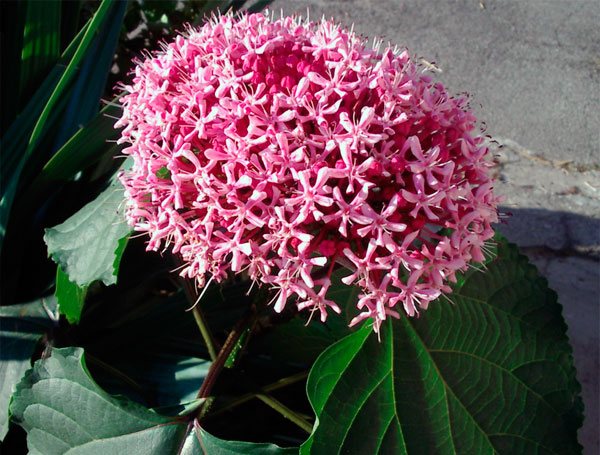

Then they are placed in containers of water and sent to a room with a temperature of about twenty-five degrees. After the young plants develop roots, they are planted in small pots, several pieces at a time, and covered with paper caps. When they are old enough, the shelter is removed and transplanted into separate containers.
Cuttings can be rooted directly in a mixture of peat and coarse sand... Before this, the sections are treated with a growth stimulant. Plants obtained in this way usually flower in the first year of growth.
Cuttings should be lignified, unripe shoots do not take root.
Diseases and pests
With improper home care, clerodendrum can suffer from various pests or diseases. The main ones, as well as methods of struggle, are described in the table.
| Disease, pest | Control measures |
| Spider mite | It infects the plant during dry periods. Aktara can get rid of this pest. |
| Whitefly | Whitefly is a rather insidious pest, and in order to get rid of it, the treatment must be carried out 3-4 times with the help of Actellik. |
| Rotting root system | With a heavy substrate and strong bays, the root system rots. Transplanting a plant with simultaneous pruning of all decaying roots will help. |
If the plant is inspected periodically once a week, then the disease or pest can be noticed at the initial stage, in which case it will be easier to get rid of it.
Care errors and problems
| Problem | What to do |
| Foliage hanging | Increased watering is required. If overdrying is a constant phenomenon, the flower dies. |
| Falling buds and flowers | Increase the humidity of the air, feed the plant with fertilizer for flowering plants. |
| Clerodendrum does not bloom | How to make it bloom: make a dormant period in winter, cut it off in spring and transplant it into new soil. |
| Overgrowth of small foliage and excessive pulling of branches | Severe lack of light, an increase in natural or artificial lighting is required. |
Clerodendrum is a beautiful plant not for novice florists. If you know how to care for Clerodendrum at home and create favorable conditions for it, it will thank you with lush flowering.
Plant care
Almost all species can be grown on the western, eastern, sometimes even northern windows, as well as in the summer in the back of the room or on the balcony. Everything need good soil moisture, protection from direct sunlight and a cool rest period. These are the minimum requirements that can be met in any home for magnificent plants such as clerodendrum.
You can learn more about growing conditions, life cycle, watering, reproduction and achieving flowering in this article.
Watch a helpful video about this plant and caring for it:
Thus, clerodendrum of all kinds - very bright decoration of any home... Unusual fragrant flowers of various shades are their main advantage. Collecting a collection of exotic plants from representatives of all available species is a very interesting thing.


